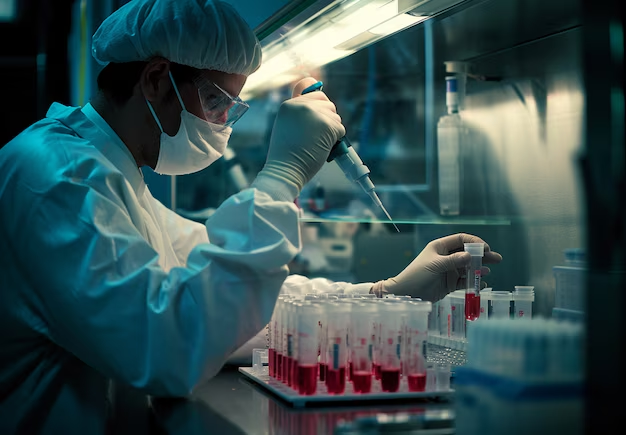What Does a High RDW Blood Test Mean? Understanding Your Results

If your RDW blood test shows high results, it can raise a lot of questions. RDW stands for Red Cell Distribution Width, which measures the size of your red blood cells. A high RDW blood test means that the red blood cells in your body are more varied in size than normal, which can point to a health issue.
A high RDW blood test is often connected to certain types of anemia, but it may also indicate other conditions. Understanding what this result means for you is important, as it can help doctors figure out what’s going on in your body. If you’ve been told that your RDW is high, don’t panic. Keep reading to learn more about this blood test result and how it may affect your health.
What Is RDW and Why Is It Important in Your Blood Test
The RDW blood test is a measurement that checks the variation in the size of your red blood cells. When your doctor orders this test, they are looking at how different or similar your red blood cells are in size. The RDW number can give your doctor important information about your health. If the RDW is high, it means there is more variation in the sizes of your red blood cells.
Your body produces red blood cells, which carry oxygen from your lungs to the rest of your body. A healthy red blood cell is typically round and uniform in size. However, when the red blood cells are different sizes, it might mean there’s an issue, like anemia or another health condition. The RDW test can help your doctor understand whether your body is making these cells properly and whether they are healthy enough to do their job.
Sometimes, high RDW numbers are linked to conditions like iron deficiency, vitamin B12 deficiency, or chronic diseases. The test is important because it can show your doctor early signs of such issues, helping them recommend treatments or lifestyle changes. It is a simple test that can give a lot of information about your body’s health.
What Does a High RDW Blood Test Really Tell You

When your RDW blood test shows high results, it usually points to an underlying health condition. A high RDW means your red blood cells vary in size more than they should. This could be a sign of anemia, a condition where your body doesn’t have enough healthy red blood cells to carry oxygen efficiently.
In some cases, high RDW could mean you have a deficiency in nutrients like iron or B12. These nutrients are necessary for your body to produce healthy red blood cells. If you’re not getting enough of these nutrients, your body might make red blood cells that are irregular in size, which shows up in the RDW blood test. Additionally, a high RDW number can sometimes point to more serious conditions like chronic liver disease or certain types of cancer.
It is important to keep in mind that a high RDW blood test is just one piece of the puzzle. It doesn’t give a full diagnosis on its own. Doctors will consider other tests and symptoms you have before making any conclusions.
Common Causes Behind High RDW Blood Test Results
There are several possible reasons why your RDW blood test might be high. Here are some of the most common causes:
Anemia: This is the most common reason for a high RDW result. Anemia can happen if your body doesn’t have enough healthy red blood cells or if the cells are not working properly. Iron-deficiency anemia and vitamin-deficiency anemia are some of the most common types.
Vitamin Deficiencies: If you’re not getting enough iron, vitamin B12, or folate in your diet, it can lead to larger-than-normal red blood cells. This causes a high RDW result.
Chronic Diseases: Conditions like kidney disease, liver disease, or chronic inflammatory conditions can affect your red blood cells, leading to high RDW numbers.
Blood Disorders: Disorders like thalassemia or sickle cell anemia can also cause a high RDW. These conditions affect how your body makes and uses red blood cells.
Alcoholism: Heavy alcohol use can damage the bone marrow, where your red blood cells are made, leading to high RDW.
Sometimes, a high RDW could be temporary, especially if it’s due to a recent illness or nutritional deficiency. However, it’s important to follow up with your doctor to understand the root cause and ensure you get the right treatment.
How Can a High RDW Blood Test Affect Your Health
A high RDW result can be an early sign that something is wrong in your body. While a high RDW alone is not a diagnosis, it can give doctors important clues about potential health problems. Depending on the underlying cause, high RDW can affect your health in different ways.
If your high RDW is due to anemia, you may feel tired, weak, or dizzy. Anemia happens when your body doesn’t have enough red blood cells to carry oxygen, which can leave you feeling exhausted. If the high RDW is due to a vitamin deficiency, you might also experience symptoms like pale skin, shortness of breath, or a rapid heartbeat.
In more serious cases, such as chronic diseases or blood disorders, high RDW can signal that your body is struggling to produce healthy red blood cells, which can lead to long-term health problems if left untreated. The good news is that many of the conditions causing high RDW can be managed with the right treatment. Whether it’s taking supplements, changing your diet, or getting treatment for an underlying condition, your doctor can guide you toward the best steps to take.
Managing High RDW Blood Test Results
If your RDW is high, it’s important to follow up with your doctor. They may recommend additional tests or treatments to determine the cause. Some people may need to change their diet to include more iron-rich foods or take vitamin supplements. Others may need treatment for chronic diseases or blood disorders. It’s important to address the cause of high RDW, as it can help improve your overall health and prevent further complications.
The Link Between High RDW Blood Test and Nutrient Deficiencies

A high RDW result can often point to nutrient deficiencies, especially iron, vitamin B12, and folate. These nutrients are essential for the production of healthy red blood cells. When your body doesn’t have enough of them, the red blood cells can become irregular in shape and size, which is reflected in the RDW test.
Iron Deficiency: Iron is vital for making hemoglobin, a protein in red blood cells that carries oxygen. Without enough iron, your body can’t make enough healthy red blood cells, leading to anemia and high RDW.
Vitamin B12 Deficiency: B12 helps your body make red blood cells. A lack of B12 can lead to larger-than-normal red blood cells, resulting in high RDW.
Folate Deficiency: Like B12, folate is important for the production of red blood cells. Low levels of folate can lead to similar issues with your red blood cells, increasing RDW levels.
If your RDW is high and you suspect a deficiency, your doctor can recommend tests to check your vitamin and iron levels. Depending on the results, they may suggest dietary changes or supplements to help correct the deficiency and bring your RDW levels back to normal.
Conclusion
If your RDW blood test shows high levels, it can be concerning. However, it’s important to remember that this is just one part of the puzzle. Many different factors, including nutrient deficiencies, anemia, and chronic conditions, can cause high RDW results. It’s essential to talk with your doctor to understand what’s behind your test result and what steps you need to take to improve your health.
Your doctor may recommend dietary changes, supplements, or further tests to find the exact cause of the high RDW. Don’t panic, but also don’t ignore the result. A high RDW can be managed, and in most cases, it’s reversible with the right treatment. By understanding what the RDW blood test means and what might be causing the high result, you can take control of your health and work with your doctor to get back on track.
FAQs
Q: What does it mean if my RDW blood test is high
A: A high RDW result means your red blood cells vary in size more than usual. It may point to anemia or other health issues like vitamin deficiencies or chronic diseases.
Q: Can high RDW be caused by a vitamin deficiency
A: Yes, a lack of vitamins like B12, folate, or iron can cause your red blood cells to be irregular in size, leading to a high RDW result.
Q: Should I be worried if my RDW is high
A: Not necessarily. While a high RDW can indicate a health issue, it’s important to talk to your doctor. They will help you understand the cause and the best treatment options.
Q: How do doctors treat high RDW levels
A: Treatment depends on the cause of the high RDW. It may involve dietary changes, supplements, or treating an underlying condition like anemia or chronic disease.
Q: Can high RDW be a sign of serious illness
A: High RDW can sometimes be linked to serious conditions like chronic disease or blood disorders. However, it can also be due to less serious causes like nutrient deficiencies. Always consult with your doctor for accurate diagnosis and treatment.



